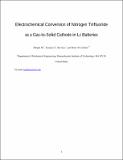Electrochemical Conversion of Nitrogen Trifluoride as a Gas-to-Solid Cathode in Li Batteries
Author(s)
He, Mingfu; Li, Yuanda; Guo, Rui; Gallant, Betar
Downloadmanuscript.pdf (1.251Mb)
Terms of use
Metadata
Show full item recordAbstract
Nonaqueous metal–gas batteries have emerged as a growing family of primary and rechargeable batteries with high capacities and energy densities. We herein report a high-capacity primary Li–gas battery that uses a perfluorinated gas, nitrogen trifluoride (NF3), as the cathode reactant. Gravimetric capacities of ∼1100 and 4000 mAh/gC are achieved at 25 and 55 °C, respectively (at 20 mA/gC), with discharge voltages up to 2.6 V vs Li/Li⁺. NF₃ reduction occurs by a 3e–/NF₃ process, yielding polycrystalline lithium fluoride (LiF) on a carbon cathode. The detailed electrochemical NF₃ conversion mechanism is proposed and supported by solid- and liquid-phase characterization and theoretical computation, revealing the origin of observed discharge overpotentials and elucidating the significant contribution of N–F bond cleavage. These findings indicate the value of exploring fluorinated gas cathodes for primary batteries; moreover, they open new avenues for future targeted electrocatalyst design and cathode materials synthesis applications benefiting from conformal coatings of LiF.
Date issued
2018-07-27Department
Massachusetts Institute of Technology. Department of Mechanical EngineeringJournal
Journal of Physical Chemistry Letters
Publisher
American Chemical Society (ACS)
Citation
He, Mingfu et al. "Electrochemical Conversion of Nitrogen Trifluoride as a Gas-to-Solid Cathode in Li Batteries." Journal of Physical Chemistry Letters 9, 16 (July 2018): 4700-4706 © 2018 American Chemical Society
Version: Author's final manuscript
ISSN
1948-7185